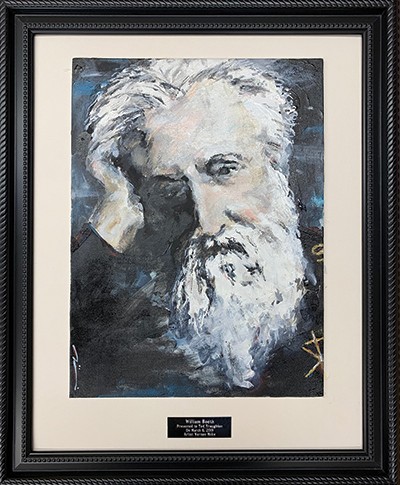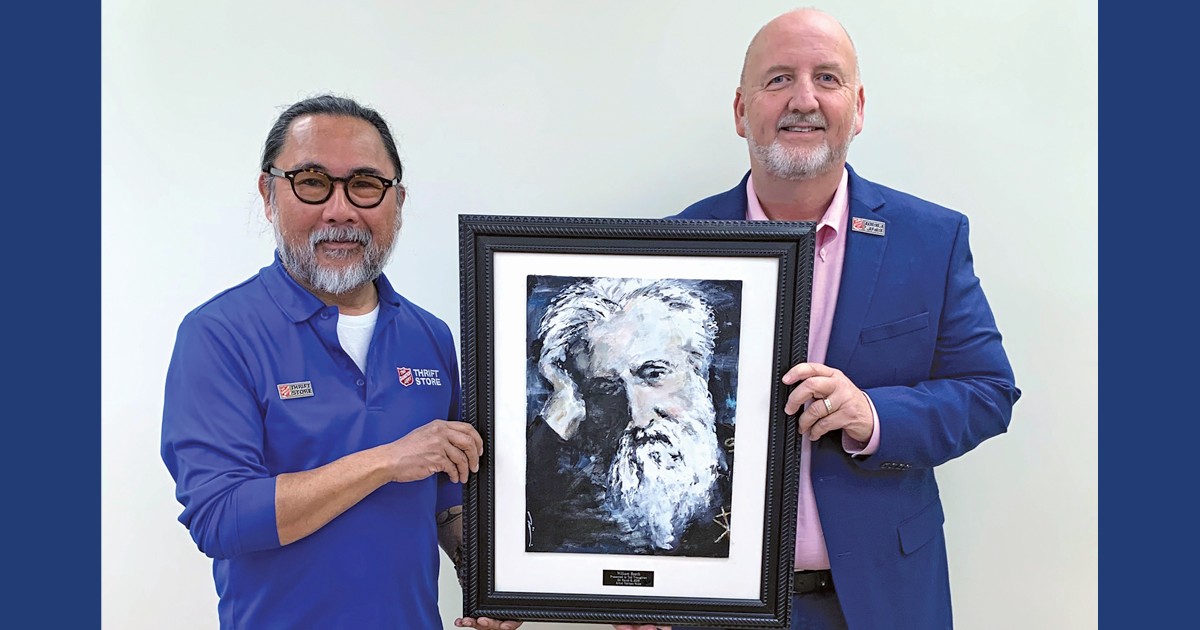Any visitor to The Salvation Army’s National Recycling Operations (NRO) headquarters in Oakville, Ont., can’t help but spot the spectacular painting of the organization’s co-Founder, General William Booth, in the office of Ted Troughton, the managing director.
The painting is the work of Vernon Miike, manager of The Salvation Army’s thrift store in Oakville. One might say that it is a fusion of decades of passion and purpose.
From Retail to Thrift
“I’ve been in retail practically my whole life,” says Vernon. “As a matter of fact, while I was going to art school, my first part-time job was as a salesman at Simpsons.”
When Vernon graduated, he was offered a position as a supervisor, which led to a retail management career at stores such as Winners and Old Navy, overseeing anywhere from 25 to 100 employees.
In 2005, he took a sabbatical to look after his parents, who were in declining health, but when he returned to the job market, Vernon was contacted by The Salvation Army. He started in July 2016.
“It feels as if my first day was just yesterday!” he smiles. “I’ve loved working here the entire time, and I hope to continue on here beyond retirement because it’s become a big part of me. I can’t see myself not being here.”
One-On-One
While Vernon had been out of the job market for a while, he figured working at a Salvation Army thrift store would be similar to his previous jobs.
“But it was different, different from anything I’d ever done before,” Vernon says.
Though the scale was the same—instead of 10 managers who had reported to him in times gone by, he has 10 staff members who do now—the interaction is more direct.
“I’m more one-on-one with my direct reports, even the part-timers, than I ever have been before.”
Vernon also puts in more time on the cash, helping with the donations and with the clientele. “The days really fly by!”
“We’re Here for a Reason”
Being up close and personal with his direct reports and the clients is not the only thing that sets what he does now apart for Vernon.
“Working at other places, you’re working for shareholders. It’s all about making money, making profit,” Vernon says. “Here, our ‘shareholders’ are all the organizations we support: the food banks, the churches, our Send a Kid to Camp campaign, the list goes on and on. How can you not feel good being part of all that?”
And while he is still in the business of being profitable, “we’re a community store,” he goes on to say. “We don’t hesitate when situations come up that require our help. We often have people coming in with vouchers, and a lot of our traffic is walk-in traffic: referrals from Army churches or correctional officers.”
Though thrift stores have drawn a trendier clientele who appreciate the variety and quality, at their heart is a mission and a mandate.
“That clientele may be growing, but we’re here because people need us to be here, now more than ever,” Vernon says. “We still have to keep in mind that we’re here for a reason. And I hope we’re here for a long time, because for many people, we’ve become a part of their lives.”
“General Booth had a belief and he had his faith, and he wasn’t doing it for the profit." VERNON MIIKE
Anatomy of a Portrait
Though retail runs in Vernon’s blood, his heartbeat is that of an artist. As a teenager, he learned to love abstract and classical fine art while in school. And throughout his career as a store manager, he regularly pursued his passion. He painted for his own enjoyment and would give many of his works away as gifts to admiring friends and relatives.
As for General Booth, Vernon first saw a sculpture of him when he came in for his job interview.
“I’ve always liked interesting faces,” he says, “and I was taken by his. I remember thinking I’d like to do a painting of him one day. And as time went on, I felt compelled to paint him.”
The hiring of Ted gave Vernon the inspiration to go ahead with the portrait.
“I thought it would be a neat little gift,” he says. “Like a lot of the pieces I do, it might have taken me a couple of days, just picking away at it.”
Vernon researched General Booth online and consulted period photographs.
“I was captivated by him,” Vernon says. “He was a man who dedicated his life to helping others, and he just seemed so emotional.”
Ted takes up the story.
“One day,” Ted relates, “Vernon brought me this beautiful painting. It really impacted me as I had never had something like that given to me in my career before. I took it home and showed my wife and kids, and they were equally impressed at Vernon’s generosity and how well it was painted.”
Unbeknownst to Ted, his wife had the painting framed, and it now hangs in his office as an ever-present memory of the mission of The Salvation Army that William and his wife, Catherine, created.
“With online meetings, this is the perfect backdrop for my camera,” Ted smiles. “One Salvation Army pastor commented on the fact that William Booth was always looking over my shoulder now at the good works of NRO!"
 Helping Others
Helping Others
Besides being proud of the work itself, this portrait is close to Vernon’s heart for other reasons.
“He’s the face behind our organization,” he states. “Prior to me working here, I’d seen the Army shield, but I never knew there was a man behind that shield.”
Since then, Vernon has become an expert on the early history of The Salvation Army.
“When General Booth started the church,” he states, “it wasn’t popular with certain people. But he had a belief and he had his faith, and he wasn’t doing it for the profit.
“I’m hoping that there’s a little bit of the General in all of us who work here,” Vernon concludes. “This is one of the reasons why I painted this portrait.”
Vernon is hard at work now on a portrait of Salvation Army co-Founder Catherine Booth, William’s wife.
This story is from:







Vernon Miike’s story is one that really resonated with me personally. The years he spent in retail are reflected in his professionalism and business philosophy, which are very truly admirable, and its very clear that he loves what he does. In addition, his art is beautifully and richly crafted, with each stroke displaying intricate understanding of art as a whole, and culminate into an exquisite piece.